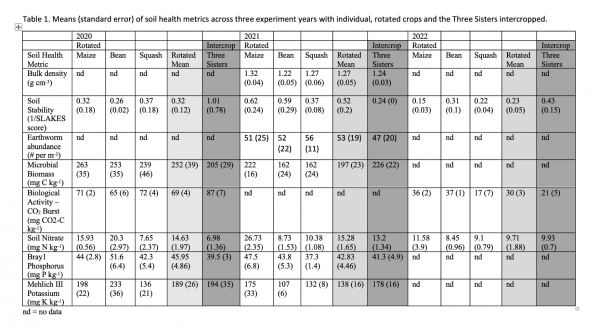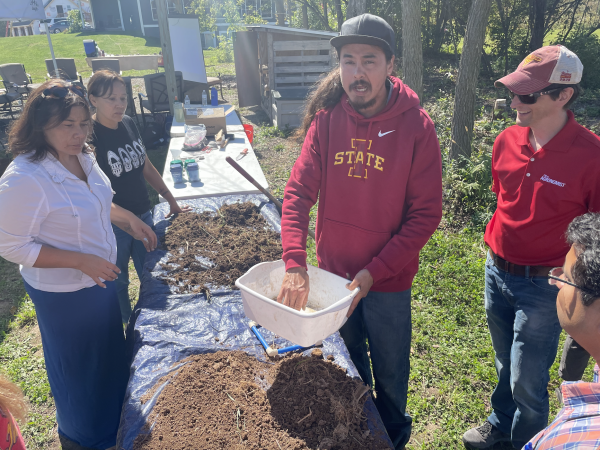 Drs. McDaniel and Nair co-led this part of the project. Drs. McDaniel and Nair set a replicated randomized complete block design with each block replicated four times at the Horticulture Research Station in Ames, Iowa. Treatments included monoculture sweet corn, monoculture common beans, monoculture squash, and intercropping of sweet corn/common beans/squash. Monoculture plots were 9 m (30’) x 9 m, whereas the intercrop plots were 12 m (40’) x 9 m. Our advisory board of Native community members suggested the varieties used at the ISU 3SI plot. Data was collected on stand establishment, weed population, weed suppression, crop growth [flowering, plant height, indirect measurement of chlorophyll (SPAD readings), and plant biomass], yield, and quality.
Drs. McDaniel and Nair co-led this part of the project. Drs. McDaniel and Nair set a replicated randomized complete block design with each block replicated four times at the Horticulture Research Station in Ames, Iowa. Treatments included monoculture sweet corn, monoculture common beans, monoculture squash, and intercropping of sweet corn/common beans/squash. Monoculture plots were 9 m (30’) x 9 m, whereas the intercrop plots were 12 m (40’) x 9 m. Our advisory board of Native community members suggested the varieties used at the ISU 3SI plot. Data was collected on stand establishment, weed population, weed suppression, crop growth [flowering, plant height, indirect measurement of chlorophyll (SPAD readings), and plant biomass], yield, and quality.
Dr. McDaniel led the soil health initiative and measured how 3SI affected soil health at the ISU plot and several small farms run by Native American communities. We used a combination of traditional soil health measurements and a novel, inexpensive, yet scientifically robust soil health indicator that engaged Native communities in citizen science. Combining these two approaches helped us determine the effect of intercropping on soil health. Furthermore, by engaging Native communities in setting up on-farm trials and soil data collection, we hoped to encourage and engage cultural links to traditional agriculture practices and promote sustainability.
Crop Yield: The 2021 growing season showed a lower average yield with the 3 Sisters. However, LER was around 2, which is considered high since the range is usually 1.22-1.3. We can interpret this as 3SI being more productive with less land but with intense limitations, including smut, bacteria pathogens, and variable environmental conditions.
Soil Health: To determine if planting the Three Sisters (maize, beans, and squash) together resulted in increased soil health, we measured several physical, biological, and chemical indicators of soil health in the Three Sisters Garden and compared them to the monocrop soil. At the end of each growing season, we sampled and determined salt-extractable Nitrate and found that intercropping the Three Sisters had consistent effects on soil nitrate, decreasing it relative to sole cropping and increasing biological activity (as assessed by CO2 Burst). Soil respiration was consistently marginally higher in the 3SI treatment, approximately 6%, even though the decomposition rates were lower in the 3SI. Other effects were inconsistent, i.e. only occurred in one year, and may be explained by either the varieties used for the year or weather conditions. It is clear that intercropping with maize, beans and squash altered soil biology and fertility. Future research should explore using stable isotope tracers to study flow of nutrients between the intercropped sisters and soil. See the charts below for more specific data results.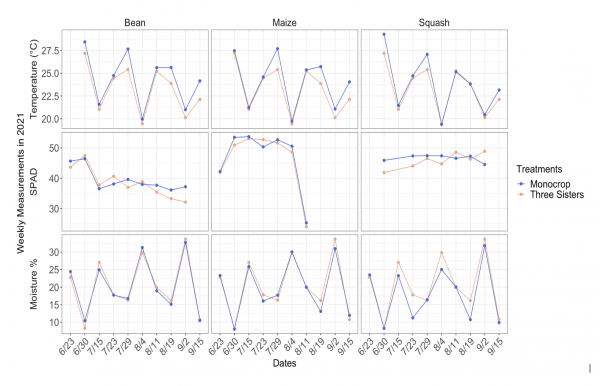
For the 2021 growing season, soil temperature, moisture and SPAD (chlorophyll proxy) were measured on a weekly basis. The blue line is the average of the monocrop treatment, and the salmon color is the Three Sisters treatment. One-way ANOVAs showed a moderate significant effect (p – value = <.01) between treatments over the whole growing season for soil temperature and moisture, but not SPAD (p-value = 0.67).
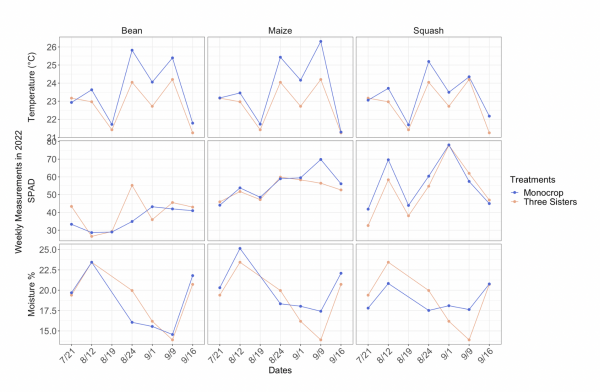
For the 2022 growing season, soil temperature, moisture and SPAD (chlorophyll proxy) were measured on a weekly basis. The blue line is the average of the monocrop treatment, and the salmon color is the Three Sisters treatment. One-way ANOVAs showed a significant effect (p – value = <.0001) between treatments over the whole growing season for soil temperature but not for soil moisture and SPAD (p-value = 0.64 & 0.53, respectively).
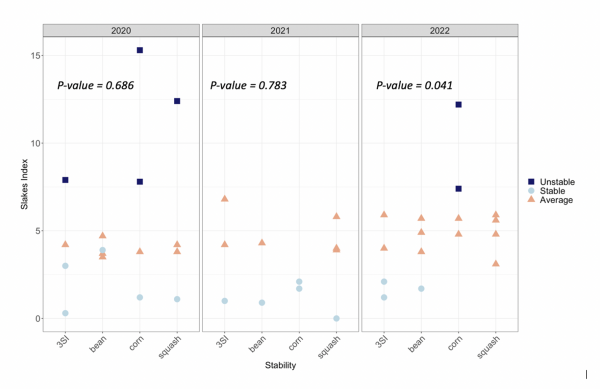
A one-way ANOVA for each year showed a non-significant effect with crop treatments for 2020 and 2021 growing season. However, a significant effect (p value = 0.041) for the 2022 growing season. The most unstable plots were from the corn monocrop treatment, and the 3SI treatment had the most stable plots in that season.
